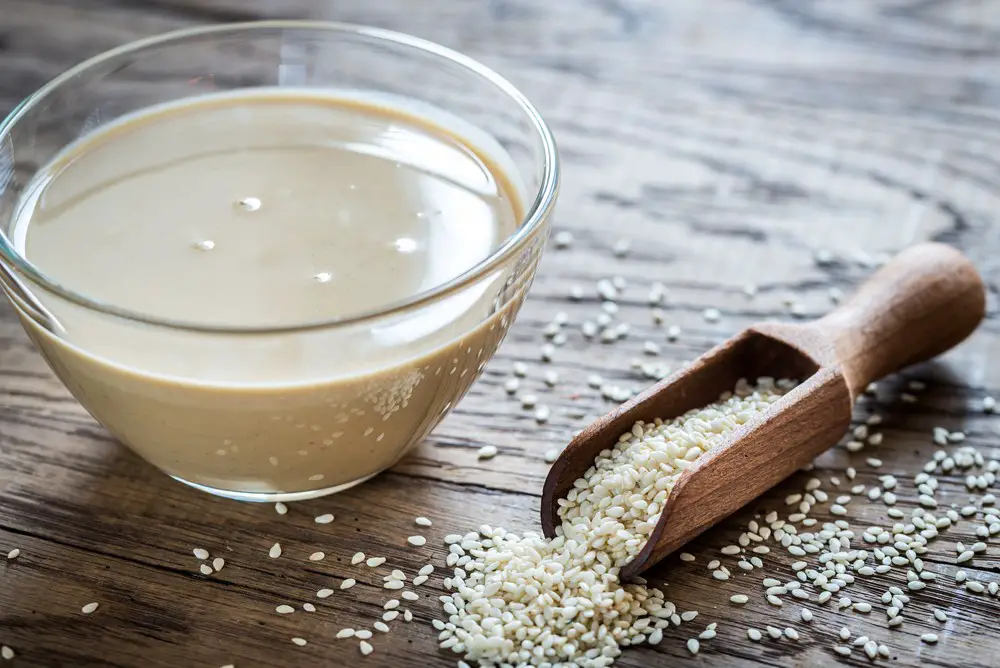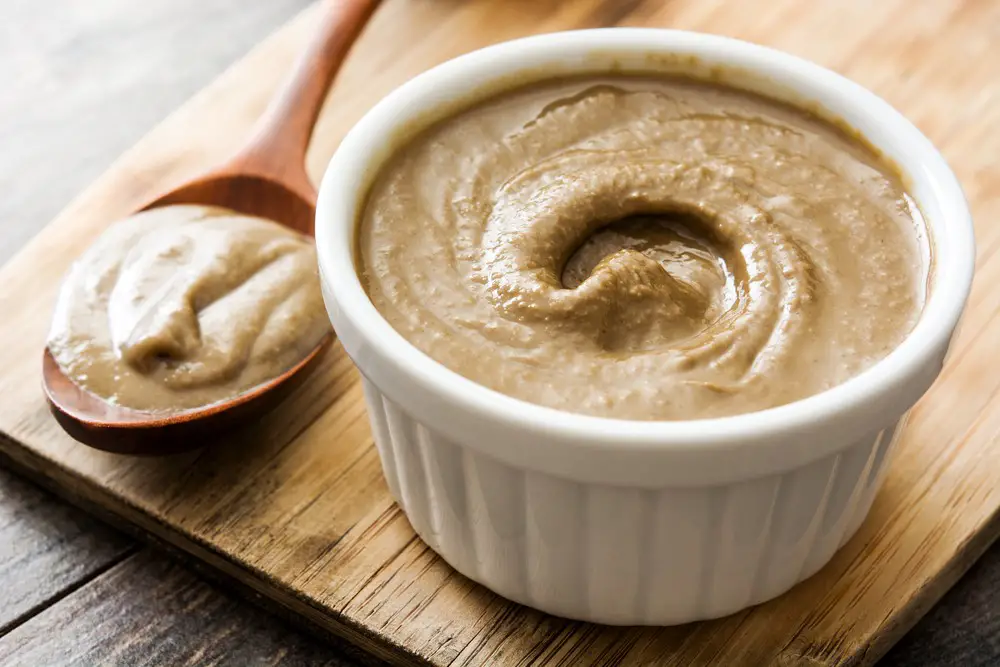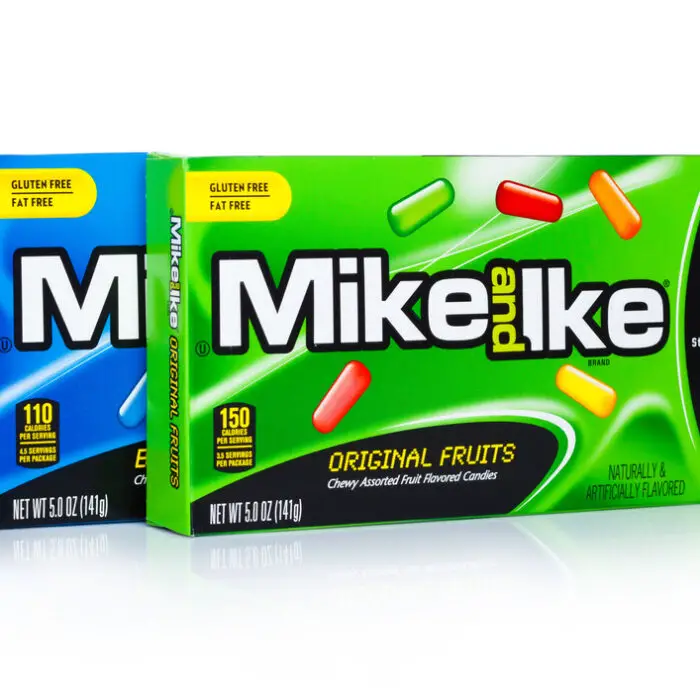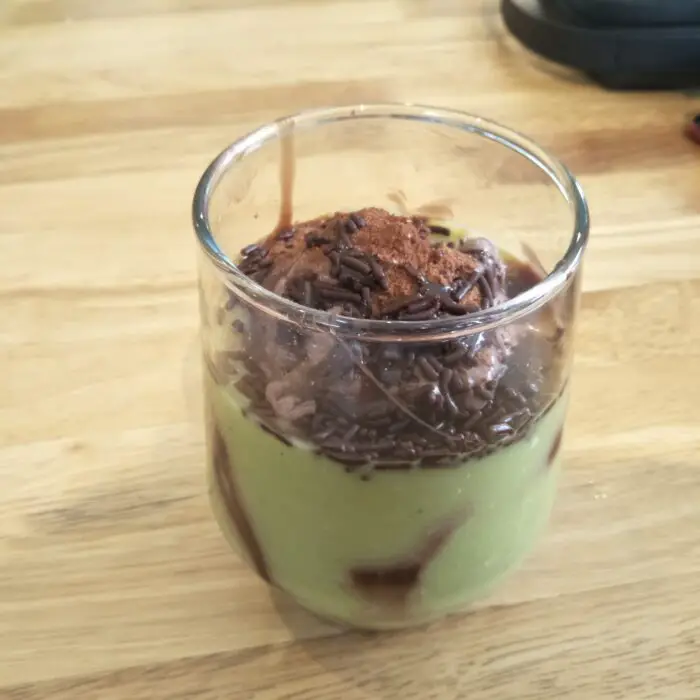Tahini, the thick paste made from lightly toasted sesame seeds, originates from the Middle East. One of the most popular uses for tahini is in the famous chickpea paste known as hummus. However, baba ghanoush, an eggplant dip, also includes tahini. You can spread it like butter over toast or use it in desserts. It’s also great for creating delicious salad dressings.
We know the Egyptians cultivated sesame seeds at least 2,000 years ago, but ancient texts by historians like Herodotus refer to tahini sauce as far back as 4,000 years ago.
The paste was initially a by-product of sesame oil production, and it’s both dairy- and animal-free, making it ideal for vegans.
The versatile sesame paste has gained popularity worldwide, but what does tahini taste like, what are its health benefits, and how can you use it at home?
What Does Tahini Taste Like?
Unlike other peanut butter types, tahini has a slightly bitter and more earthy flavor. The paste is made with hulled, slightly roasted sesame seeds and does not have the same sweet flavor profile as other kinds of nut butter. Because of the high oil content of tahini, its best kept in a refrigerator to ensure its freshness.
Sometimes the seeds for tahini paste aren’t hulled, leading to a darker and even more bitter paste referred to as tahini butter.

What’s In Tahini
According to WebMD, one tablespoon of tahini paste is packed with proteins, fiber, vitamins, and minerals and only contains 89 calories. It also has only monounsaturated fats and is an excellent way to add vitamins B1 and B2 to your diet. Here are the best nutritional values of including 1 tablespoon into your diet:
- Protein: 3 grams
- Carbs: 3 grams
- Fat: 8 grams
- Fiber: 2 grams
- Copper: 27% daily value
- Selenium: 9% daily value
- Phosphorus: 9% daily value
- Iron: 7% daily value
- Zinc: 6% daily value
- Calcium: 5% daily value
Benefits of Copper
The copper in tahini is a vital trace nutrient that can help the body in several ways. These include:
- Better iron absorption, helping to prevent anemia
- Controls blood pressure
- It promotes red blood cell production
- Supports the immune system
- Turns sugar into energy
Other Powerful Compounds Found in Tahini
Selenium is an antioxidant and assists the body to fight inflammation.
Another component found in sesame seeds, sesamol, has shown several benefits in studies. These include antioxidant, anti-inflammatory, and anti-aging. According to some studies, sesamol may help prevent cancer.
Sesame seeds have more plant compounds called phytosterols than other nuts and seeds, making them more effective in lowering cholesterol levels.
Allergy Risks
If you know you are allergic to sesame seeds, don’t eat tahini. However, you may not know you have an allergy to the seeds. If you have any of the following symptoms after eating tahini, go to the doctor immediately:
- You get an itchy or tingling feeling in your mouth
- You suddenly have a hive or eczema outbreak or a very itchy skin
- You have sudden swelling on the tongue, throat, lips, face, tongue, or elsewhere
- You suddenly feel wheezy or have a stuffy nose
- You have diarrhea, sudden vomiting, or generally feel like you have an upset stomach
Even though tahini allergies are rare, anaphylaxis, a severe allergic reaction, can be life-threatening and requires immediate medical attention. Call 911 if you find breathing difficult, have a tightening in the throat, have palpitations, a sudden drop in blood pressure, or feel dizzy. If a person loses consciousness, seek emergency help.

Why Include Tahini in Your Diet?
The smooth texture of tahini comes from the high-fat content of sesame seeds which contain 55% oil. Despite being high in calories, you only need a small amount to get its healthy fats, essential amino acids and feel full for longer between meals.
The healthy fats in tahini protect your heart health since it helps improve total cholesterol levels. Tahini is rich in antioxidants that fight inflammation and free radicals. These appear to protect the body in several ways, including against osteoarthritis, rheumatoid arthritis, asthma, and cancer.
Researchers have started to delve deeper into how sesame seeds can help protect nerve cells and brain health. These studies are still in their early stages, but some antioxidants in the seeds may help reduce the risk of dementia and Alzheimer’s, both neurodegenerative diseases.
Vegans need a good plant-based source of calcium, and the sesame seed paste has an excellent quantity. Tahini also encourages the absorption of the fat-soluble vitamins A and E and zinc, all of which help maintain your skin supple and glowing.
If these reasons for including tahini in your diet aren’t enough, this article on Healthline provides more details about its benefits.
How to Use Tahini
Tahini gives hummus and baba ghanoush their deliciously creamy and earthy flavor. These pastes are very popular in the Middle East and Eastern Mediterranean countries, enjoyed by vegans and meat eaters as dips or accompaniments to their foods.
Start your day with a slice of your favorite bread smeared with tahini, or use the paste with raw vegetable sticks as a dip.
Add flavor to your usual sandwich fillings, grills, grain bowls, or salads by making a tahini drizzle. Use your imagination when creating your tahini drizzle, but remember it combines well with ingredients like basil, garlic, and onions. You can use either lemon or vinegar to add a hint of tartness.
If you want to add tahini to sweets or desserts, there are several ways to enjoy the nutty spread. Try the delicious confection known as halva. Sold in stores, it resembles fudge but has the characteristic flavor of tahini with a touch of sweetness. You can also use crumbled halva or tahini to create frozen desserts, cookies, and pastries.
Tips For Choosing and Storing Tahini
When selecting tahini, look for a product without additives. Avoid jars with added sugar or salt, as the natural flavor of the paste is best when kept as pure as possible.
If you buy packaged tahini, check if it’s been blended correctly, e.g., no chunks of sesame seeds are visible in the jar. If all looks okay, take a spoonful and taste it to ensure you like the flavor profile before purchasing it.
Due to its high-fat content, store tahini in your refrigerator after opening. It has a long shelf life—up to two years—but keeping it in cold conditions will help preserve its freshness and flavor.
You can also freeze tahini for up to six months without affecting its quality. To do this, portion it into small amounts in airtight containers before freezing. When you need some, thaw it in the refrigerator overnight, ready for use the next day.
How to Make Your Own Tahini
Making your own tahini at home is quite easy. To do this, you’ll need to gather some sesame seeds and a food processor or high-powered blender.
First, dry roast the seeds in an oven for about 10 minutes. This will bring out the flavor of the sesame seeds and make them easier to blend. Once they’ve cooled off, place them into a food processor or blender and start blending until it reaches a smooth texture. Add olive oil while blending to give it a more creamy consistency if desired.
And that’s it! You now have homemade tahini that can be stored in an airtight container in the fridge for up to one month. Use it in recipes like hummus or to make a tahini sauce for salads and other meals. Enjoy!
Tips For Making The Best Tahini
For the best-tasting tahini, make sure you buy sesame seeds of good quality. Roast them in a moderate oven until fragrant, lightly browned, but never burnt. When blending the paste, add only enough oil as needed to keep it smooth. Too much oil will make your tahini too wet and runny, while not adding enough will make it dry and crumbly. Finally, store your finished tahini in an airtight container in the refrigerator, which can keep for up to one month.
These tips should help you enjoy homemade tahini at its best.
Final Take
If you still haven’t tried tahini and ask yourself what tahini tastes like, we have covered its flavor profile, health benefits, and uses. Ongoing research in several areas shows promising health benefits from consuming sesame seeds.
Tahini has been around longer than all the other peanut butter varieties but remains relevant in the modern diet. You can include it into your diet in several ways to ensure you get the promising benefits of this interesting, slightly bitter nutty paste.
FAQs
Is tahini good for cholesterol?
Yes, tahini is beneficial for lowering cholesterol levels when eaten in moderation as part of a balanced diet.
How long does Tahini last?
Tahini lasts up to two years if stored properly in the refrigerator, and it can be frozen for up to six months.
Is Tahini vegan-friendly?
Yes, tahini is vegan-friendly as it comes from vegan sesame seeds containing no animal products. It’s also full of calcium, making it an excellent alternative mineral source for vegans or lactose intolerant.
Can you eat tahini on its own?
Yes, you can spread it directly onto your toast or add it to smoothies for a nutty flavor. You can also use it as a dip with various snacks such as vegetable sticks.
Are there any side effects to consuming tahini?
In rare cases, some people may be allergic to sesame seeds and therefore experience anaphylaxis if they consume tahini. If this is the case, seek emergency medical help. Otherwise, no side effects from consuming tahini when eaten in moderation are known.







